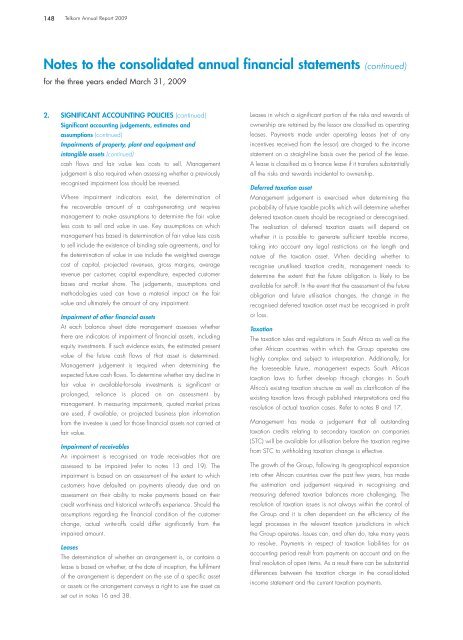Telkom AR front.qxp
Telkom AR front.qxp
Telkom AR front.qxp
Create successful ePaper yourself
Turn your PDF publications into a flip-book with our unique Google optimized e-Paper software.
148<br />
<strong>Telkom</strong> Annual Report 2009<br />
Notes to the consolidated annual financial statements (continued)<br />
for the three years ended March 31, 2009<br />
2. SIGNIFICANT ACCOUNTING POLICIES (continued)<br />
Significant accounting judgements, estimates and<br />
assumptions (continued)<br />
Impairments of property, plant and equipment and<br />
intangible assets (continued)<br />
cash flows and fair value less costs to sell. Management<br />
judgement is also required when assessing whether a previously<br />
recognised impairment loss should be reversed.<br />
Where impairment indicators exist, the determination of<br />
the recoverable amount of a cash-generating unit requires<br />
management to make assumptions to determine the fair value<br />
less costs to sell and value in use. Key assumptions on which<br />
management has based its determination of fair value less costs<br />
to sell include the existence of binding sale agreements, and for<br />
the determination of value in use include the weighted average<br />
cost of capital, projected revenues, gross margins, average<br />
revenue per customer, capital expenditure, expected customer<br />
bases and market share. The judgements, assumptions and<br />
methodologies used can have a material impact on the fair<br />
value and ultimately the amount of any impairment.<br />
Impairment of other financial assets<br />
At each balance sheet date management assesses whether<br />
there are indicators of impairment of financial assets, including<br />
equity investments. If such evidence exists, the estimated present<br />
value of the future cash flows of that asset is determined.<br />
Management judgement is required when determining the<br />
expected future cash flows. To determine whether any decline in<br />
fair value in available-for-sale investments is significant or<br />
prolonged, reliance is placed on an assessment by<br />
management. In measuring impairments, quoted market prices<br />
are used, if available, or projected business plan information<br />
from the investee is used for those financial assets not carried at<br />
fair value.<br />
Impairment of receivables<br />
An impairment is recognised on trade receivables that are<br />
assessed to be impaired (refer to notes 13 and 19). The<br />
impairment is based on an assessment of the extent to which<br />
customers have defaulted on payments already due and an<br />
assessment on their ability to make payments based on their<br />
credit worthiness and historical write-offs experience. Should the<br />
assumptions regarding the financial condition of the customer<br />
change, actual write-offs could differ significantly from the<br />
impaired amount.<br />
Leases<br />
The determination of whether an arrangement is, or contains a<br />
lease is based on whether, at the date of inception, the fulfilment<br />
of the arrangement is dependent on the use of a specific asset<br />
or assets or the arrangement conveys a right to use the asset as<br />
set out in notes 16 and 38.<br />
Leases in which a significant portion of the risks and rewards of<br />
ownership are retained by the lessor are classified as operating<br />
leases. Payments made under operating leases (net of any<br />
incentives received from the lessor) are charged to the income<br />
statement on a straight-line basis over the period of the lease.<br />
A lease is classified as a finance lease if it transfers substantially<br />
all the risks and rewards incidental to ownership.<br />
Deferred taxation asset<br />
Management judgement is exercised when determining the<br />
probability of future taxable profits which will determine whether<br />
deferred taxation assets should be recognised or derecognised.<br />
The realisation of deferred taxation assets will depend on<br />
whether it is possible to generate sufficient taxable income,<br />
taking into account any legal restrictions on the length and<br />
nature of the taxation asset. When deciding whether to<br />
recognise unutilised taxation credits, management needs to<br />
determine the extent that the future obligation is likely to be<br />
available for set-off. In the event that the assessment of the future<br />
obligation and future utilisation changes, the change in the<br />
recognised deferred taxation asset must be recognised in profit<br />
or loss.<br />
Taxation<br />
The taxation rules and regulations in South Africa as well as the<br />
other African countries within which the Group operates are<br />
highly complex and subject to interpretation. Additionally, for<br />
the foreseeable future, management expects South African<br />
taxation laws to further develop through changes in South<br />
Africa’s existing taxation structure as well as clarification of the<br />
existing taxation laws through published interpretations and the<br />
resolution of actual taxation cases. Refer to notes 8 and 17.<br />
Management has made a judgement that all outstanding<br />
taxation credits relating to secondary taxation on companies<br />
(STC) will be available for utilisation before the taxation regime<br />
from STC to withholding taxation change is effective.<br />
The growth of the Group, following its geographical expansion<br />
into other African countries over the past few years, has made<br />
the estimation and judgement required in recognising and<br />
measuring deferred taxation balances more challenging. The<br />
resolution of taxation issues is not always within the control of<br />
the Group and it is often dependent on the efficiency of the<br />
legal processes in the relevant taxation jurisdictions in which<br />
the Group operates. Issues can, and often do, take many years<br />
to resolve. Payments in respect of taxation liabilities for an<br />
accounting period result from payments on account and on the<br />
final resolution of open items. As a result there can be substantial<br />
differences between the taxation charge in the consolidated<br />
income statement and the current taxation payments.




